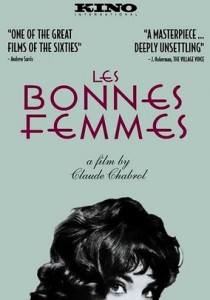Les Bonnes Femmes-1960
Director Claude Chabrol
Starring Bernadette Lafont
Top 250 Films #180
Scott’s Review #303
Reviewed December 19, 2015
Grade: A
Les Bonnes Femmes (1960) is a French film by Claude Chabrol, an excellent director whom I was shamefully unfamiliar with, save for the recently viewed Les Biches, made in 1968.
He has been labeled the French equivalent of Alfred Hitchcock, which is an accurate statement.
Les Bonnes Femmes is a brilliant film that came about during the experimental New Wave films of the 1960s and cannot be forgotten upon viewing it.
It has resonated with me, and I cannot stop thinking and analyzing it.
The film centers on four shopgirls living in Paris, all of whom happen to be young and beautiful and mysteriously look similar to one other. Their names are Jane, Jacqueline, Ginette, and Rita.
They are rather bored with their lives and meander aimlessly through life and the doldrums of their job by looking forward to social occasions, which mainly include men.
The girls party (some more than others), date, go to the zoo, swim, and enjoy typical young lady festivities.
So far, the film might sound like a typical, lighthearted, nice story- think a French Sex and the City. It is, by and large, this way on the surface, but throughout the film, there is a calm sense of dread- like something bad might be lurking in the shadows of coming around the bend.
One day, while the girls are at the zoo, a mysterious individual begins following them, though the viewer has no idea why or who it is.
The film contains more than a sense of dread. Instead, a sense of chilling violence is in the air. A brooding, cold, ugly feeling transpires due to superior direction and overall mood.
Paris, one of the world’s most gorgeous cities, appears bleak, dark, and gloomy throughout the film. The black-and-white cinematography undoubtedly adds to this, as greyness envelopes every shot.
Throughout Les Bonnes Femmes, there is plenty of foreshadowing as situations arise that give a sense of danger or that something terrible is imminent.
Early in the film, two girls are walking along the street when they are approached by two men in a car wanting to party with them. They accept, and the viewer wonders what a bad decision they may have made. The men wine and dine the women, who are looking for love.
One of the girls is quite a bit more reserved than the other and ends up spending the night with the men. Later, the shop owner tells a story about how she once acquired a serial killer’s bloody handkerchief after he was guillotined and has kept it for years.
Creepy? Yes.
The tigers snarling at the girls when they visit the zoo is laced with symbolism as is a, at first, fun game at the pool, as the men dunk the girl’s heads underwater until things escalate towards danger.
Jacqueline, the sweetest of the girls, meets a motorcycle man and spends time together. They are happy. The irony is that during these later scenes, in which an act of brutality occurs (one character is murdered), the tone is suddenly sunny, warm, and bright. A lovely afternoon in the woods quickly turns evil.
This was a shocking scene, as I was caught off guard. The ending of the film can be discussed in vast detail.
During the murder, it almost seems like the victim is welcoming death. Could this be? Additionally, is one of the shop girls his next intended victim, or is a new girl the killer’s next target?
In the final shot, we see him dancing with a girl, but it is unclear (at least to me) if it is one of the shopgirls.
Chabrol is not a happily-ever-after director. His films are known to be stormy, with dread looming. However,t they are also laced with style, sophistication, and a dark appeal.
I cannot wait to sink my teeth into more of his works.
